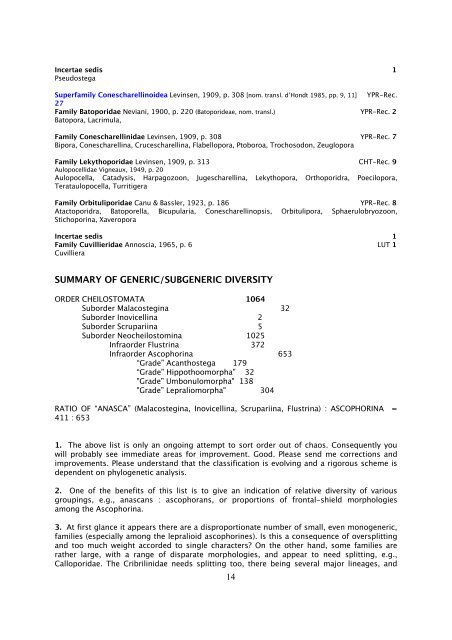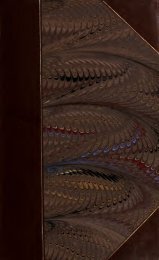BRYOZOA: CHEILOSTOMATA Interim classification for Treatise ...
BRYOZOA: CHEILOSTOMATA Interim classification for Treatise ...
BRYOZOA: CHEILOSTOMATA Interim classification for Treatise ...
Create successful ePaper yourself
Turn your PDF publications into a flip-book with our unique Google optimized e-Paper software.
Incertae sedis 1<br />
Pseudostega<br />
Superfamily Conescharellinoidea Levinsen, 1909, p. 308 [nom. transl. d’Hondt 1985, pp. 9, 11] YPR-Rec.<br />
27<br />
Family Batoporidae Neviani, 1900, p. 220 (Batoporideae, nom. transl.) YPR-Rec. 2<br />
Batopora, Lacrimula,<br />
Family Conescharellinidae Levinsen, 1909, p. 308 YPR-Rec. 7<br />
Bipora, Conescharellina, Crucescharellina, Flabellopora, Ptoboroa, Trochosodon, Zeuglopora<br />
Family Lekythoporidae Levinsen, 1909, p. 313 CHT-Rec. 9<br />
Aulopocellidae Vigneaux, 1949, p. 20<br />
Aulopocella, Catadysis, Harpagozoon, Jugescharellina, Lekythopora, Orthoporidra, Poecilopora,<br />
Terataulopocella, Turritigera<br />
Family Orbituliporidae Canu & Bassler, 1923, p. 186 YPR-Rec. 8<br />
Atactoporidra, Batoporella, Bicupularia, Conescharellinopsis, Orbitulipora, Sphaerulobryozoon,<br />
Stichoporina, Xaveropora<br />
Incertae sedis 1<br />
Family Cuvillieridae Annoscia, 1965, p. 6 LUT 1<br />
Cuvilliera<br />
SUMMARY OF GENERIC/SUBGENERIC DIVERSITY<br />
ORDER <strong>CHEILOSTOMATA</strong> 1064<br />
Suborder Malacostegina 32<br />
Suborder Inovicellina 2<br />
Suborder Scrupariina 5<br />
Suborder Neocheilostomina 1025<br />
Infraorder Flustrina 372<br />
Infraorder Ascophorina 653<br />
“Grade” Acanthostega 179<br />
“Grade” Hippothoomorpha” 32<br />
"Grade” Umbonulomorpha" 138<br />
"Grade” Lepraliomorpha" 304<br />
RATIO OF “ANASCA” (Malacostegina, Inovicellina, Scrupariina, Flustrina) : ASCOPHORINA =<br />
411 : 653<br />
1. The above list is only an ongoing attempt to sort order out of chaos. Consequently you<br />
will probably see immediate areas <strong>for</strong> improvement. Good. Please send me corrections and<br />
improvements. Please understand that the <strong>classification</strong> is evolving and a rigorous scheme is<br />
dependent on phylogenetic analysis.<br />
2. One of the benefits of this list is to give an indication of relative diversity of various<br />
groupings, e.g., anascans : ascophorans, or proportions of frontal-shield morphologies<br />
among the Ascophorina.<br />
3. At first glance it appears there are a disproportionate number of small, even monogeneric,<br />
families (especially among the lepralioid ascophorines). Is this a consequence of oversplitting<br />
and too much weight accorded to single characters? On the other hand, some families are<br />
rather large, with a range of disparate morphologies, and appear to need splitting, e.g.,<br />
Calloporidae. The Cribrilinidae needs splitting too, there being several major lineages, and<br />
14

















